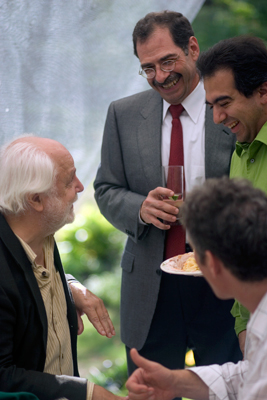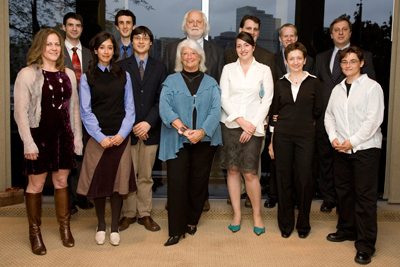Donor Profile: A. Neil & Jane Pappalardo
A. Neil (SB EE ’64) & Jane Pappalardo

by Elizabeth Chadis, Director of Development // MIT Physics Annual 2007
Watch Neil Pappalardo as he questions junior faculty on the exact number of exoplanets, or how specifically gravitational waves can be measured, and you’ll see the passion and persistence behind the MEDITECH founder and father of four. A child of Sicilian immigrants from a small village outside of Rochester, New York, Neil came to MIT, studied physics, and went on to found of one of the largest privately-held software companies in the world.
When he was in the 8th grade, Neil Pappalardo announced to his parents he would attend MIT. He knew it was a prestigious institution that smart people attended but not much more. His parents enrolled him at a Jesuit high school where he was encouraged to study the classics rather than focusing on the math and science skills that he would later learn at MIT. Neil followed this advice and took four years of Greek and Latin. He graduated from the high school without a single science class and a mere two years of math. During his junior year he visited MIT and was surprised to find that the Institute had course requirements for admission and that science and math were high on the list. Undaunted, as math had always come easily, Neil scored well on his SATs, and applied to the one school his heart was set on. He was the first from his high school to attend MIT.
Neil has always loved physics, particularly astrophysics and cosmology, and for three and half years he was a course 8 major with every intention of graduating with a physics degree. But then something happened. He learned he had to write a thesis in order to graduate and it had to be something original and creative. A professor in the electrical engineering department suggested Neil talk to some cardiologists who had a problem and needed help. Neil agreed to help the physicians by developing a medical device that would electronically examine the electrical signal from a patient’s heart for arrhythmia. His device not only functioned, it worked exactly as intended. It became Neil’s thesis, fulfilling the degree requirement that enabled Neil to graduate, albeit with a degree in electrical engineering rather than physics.
Throughout our entire marriage, there has been a stack of physics and cosmology books piled next to Neil’s side of the bed.
Jane Pappalardo
Neil met his future wife, Jane Langevin, in October of his senior year. Jane remembers, “We met at 2:30 in the afternoon at his fraternity. Neil was just getting out of bed. Classes held no interest for him and he would sleep late every day. Soon afterward, they were ‘pinned’ (remember, this was 1963). Neil and Jane were engaged in January 1964 and married that August. After graduation, Neil worked at Mass General Hospital, where he began to write the software that would automate the hospital’s clinical laboratory. “Because I was so totally unaware of the scope of this undertaking, I was undaunted,” he notes. For the next few years, Neil continued to search out other areas within the hospital ripe for automation.
In November 1968, Jane announced she was pregnant with their fourth child. Neil decided the time was right to create his own company to provide the software automation solutions he had developed and market them to other hospitals. He put together a business plan and began knocking on the doors of venture capitalists. There were two problems: he was an inexperienced 26 year-old, and no one knew what software was. Nevertheless, he persevered and eight months later, on August 4, 1969, both Medical Information Technology (MEDITECH) and Missy (the baby) were born.
Today MEDITECH is one of the world’s oldest software companies. Its integrated information system is installed in more than 2,000 hospitals throughout the United States, Canada, and the United Kingdom. Neil mentions that he is very proud of the fact that MEDITECH hires only entry level employees and promotes only from within. The company has five unique locations situated along Route 128 just outside Boston and is currently building a new 130,000-square foot facility on a 17-acre site in Fall River, MA, for customer service and training. “I only buy top quality buildings with unique attributes that can provide an enjoyable work space for our employees.” One facility has a race track, another sits in the middle of a golf course. Each facility comes with elegant employee dining areas, common spaces with abundant natural light, and numerous works of art, many by local artists.
Whenever I make a gift, I make sure that the gift will make the Department even better than it is.
Neil Pappalardo SB EE ’64
When he’s not at MEDITECH, Neil’s at MIT. He is a life member of the MIT Corporation and serves on the Corporation’s Executive and Auditing Committees, as well as three visiting committees, for Mechanical Engineering, the Libraries and Physics. Jane, who graduated from Boston University with a degree in music, is a member of the MIT Council of the Arts.

Pappalardo Fellows.
Neil’s renewed involvement with the Physics Department began in earnest in 1996. There was some concern that MIT’s astrophysics division might become in danger of losing out to competitive institutions in attracting the younger generation of astrophysicists. The Department needed access to one of the world-class optical telescopes that were then being built. Neil listened when Professors Claude Canizares and Paul Schechter talked about the critical difference this access would make for the Department. It was a very straightforward argument: “With a giant telescope we’d be able to attract brilliant young astronomers and the most promising graduate students.” Supporting the Magellan telescopes project was clear cut. Neil and Jane decided to help fund the construction of the world-class Magellan optical telescope observatory in Chile. “What we set out to accomplish, we accomplished. Today, astrophysics at MIT is second to none.”
Not long afterward, the Department of Physics once again asked for Neil’s help with another challenge. New Department Head Marc Kastner wanted to establish a postdoctoral fellowship program that would identify, recruit, and support talented and promising young physicists. Again, convinced it would make the Physics Department even stronger, Neil told Marc and Dean of Science Bob Birgeneau just how it could be done and how it could be financed. Nine years later, the Pappalardo Fellowships in Physics is one of the most prestigious and emulated programs of its kind in the world. Professor Bob Jaffe, former Director of the Center for Theoretical Physics, calls Neil “a visionary supporter of the MIT Physics Department. The Pappalardo Fellowship Program has made the Department the destination for the brightest young physicists.” Current Pappalardo Fellow Henriette Elvang echoes her colleagues when she calls Neil and Jane “amazing.” She explains: “They genuinely care about us and our careers. Their level of personal engagement is just mind-blowing; they come to our presentations [annual Pappalardo Fellowships symposium] and they want to see us do well. We are invited into their home, we know their family and they know ours. It’s a unique situation and we all feel very fortunate.” Three former Fellows thus far have joined the MIT physics faculty, and many others have gone on to tenure track positions at other prestigious institutions.
Neil Pappalardo is the soul of the Physics Department.
Frank Wilczek, Herman Feshbach Professor Physics; 2004 Nobel Laureate
For 25 years, the Physics Department has dreamed about and worked for a home of its own on campus. In August 2002, an arrangement was reached, at last, to bring most of physics together in Buildings 4, 6, and 8. The Department thought it had the go-ahead but in the final hour, the Institute administration said more money was needed. Despair and discouragement filled the infinite corridor around Building 6 until Neil, once again, came to the rescue. Neil said he and Jane would provide $5 million for the project if the Department could raise an additional $5 million. With this challenge and an influx of optimism, encouragement, and persistence, the Department raised the additional $5 million in less than a year.
The Green Center for Physics will be dedicated on October 5, 2007. The MIT Department of Physics is in the best shape ever, and in large part, we have Neil and Jane to thank for it.